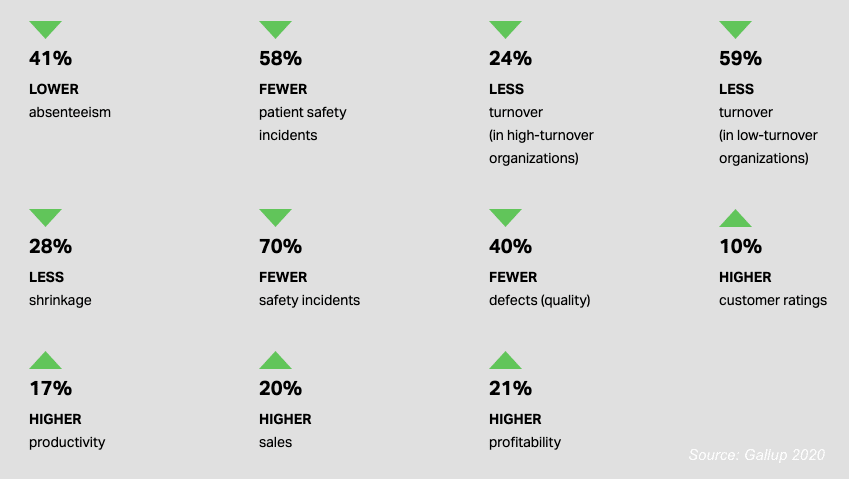





The potential of employee surveys is enormous. If carried out correctly, it is the instrument par excellence for having a lasting effect on the satisfaction of your employees, identifying internal problems and gaining valuable insights into company processes.
One question however remains: Are traditional employee surveys at all appropriate for the modern working world?
Here’s our take: Traditional employee surveys have to go! Rigid survey methods need to be replaced by a flexible, easy-to-use solution that makes participation in surveys attractive while providing up-to-date and reliable data.
Here’s what we’ll be covering in this article:
- Benefits of Employee Surveys
- Increasing Employee Satisfaction with Employee Surveys
- Do’s and Don’ts
- Questionnaire Creation
What Benefits Can You Draw From Employee Surveys?
Employee surveys are an all-round method to foster engagement and can be used in various ways.
Drive Motivation
Uncover motivation barriers of your employees and identify effective countermeasures.
Identify Problems Early
Are all work processes running smoothly? Is there any friction between direct superiors and/or conflicts between colleagues? The guarantee of anonymity prompts survey participants to answer even the most uncomfortable questions honestly.
Build Trust
Once companies give their employees a voice, they start building a relationship that reflects mutual trust
Generate Key Figures
Valid and up-to-date data are indispensable for managing your team.
Retain Employees
Good work goes hand-in-hand with appreciation and fairness: by listening to your employees and by giving them a channel through which they can be heard, you will receive gratitude for your dedicated effort in return.
Extend Your Knowledge Base
No matter how good an external consultant may be – no one is as close to the day-to-day business and customers as your employees. Use this to your mutual advantage.
Increasing Employee Satisfaction with Employee Surveys
The driving force of a company is no longer the product or an individual visionary. Especially in times of talent scarcity, employees are turning out to be the key factor for a successful business. No matter how good the product or idea may be – the road to success is paved by your staff. That is why it is important to create a working environment in which employees can develop their potential in the best possible way.

Adapt the working conditions as best as you can to the needs of the employees. If you however expect to find a one-size-fits-all method in this scenario, you will be looking in vain. Personnel needs can vary greatly depending on the industry – but also depending on individual departments.
This is where the employee survey comes in – because in this case who could be a better contact person than the employees themselves?
If employee surveys are conducted poorly and irregularly, companies become susceptible to blind spots. Frustration and annoyance on the side of the employees will continue to grow and lead to the inevitable consequence: an increase in turnover.
60% of companies conduct employee surveys only once every two years. As a result, they miss out on valuable insights into the well-being of their employees and the chance to improve issues that their employees find important.
Employee Surveys 2.0
As described above, traditional survey methods are simply no longer up to date. The fact is that the business world is constantly changing. Production cycles are getting shorter, work requirements are becoming more complex, and what was considered important yesterday may already be obsolete today.
Paper-Pencil surveys can hardly keep up with this because of following reasons:
- Complex evaluation of the collected data
- Long time intervals between survey and evaluation
- Semi-annual or annual surveys are too irregular
- Surveys are too extensive and perceived as annoying
Digitalized employee surveys, on the other hand, guarantee
- All the data you need at a glance and without time delay
- Compact surveys in regular intervals
- Enormous time saving through automated evaluation
- Flexibility with the optimal mix of standardized questionnaires and the input of situation-dependent additional questions
Employee Surveys: Powerful and Sensitive
As effective employee surveys may be – there are some pitfalls to look out for. The content and procedural design require a considerate and forward-looking approach because even small mistakes can lead to a considerable loss of acceptance and trust among the workforce!
DONT’s
- Missing follow-up measures – Back up your insights with initiatives
- Whitewashing – Address difficult topics instead of ignoring them
- Manipulation – Attempts by management to generate good survey results
- Subsequent removal of anonymity
DO’s
- Early and transparent communication about the goal and significance of the employee survey
- Involvement of the works council to increase acceptance
- Professional foresight and planning
- Careful Phrasing of questions
So far, so good. Let’s go more into detail now.
Questionnaire Creation
The more relevant the topic, the more complex it will become to create an employee survey about it. If we think of employee satisfaction, for example, a wide range of influencing factors come to mind. To name but a few, the relationship with colleagues, promotion opportunities within the company or the design of the workplace can have a significant impact on staff satisfaction.
The question “how satisfied are you in your current position” is not enough at this point. Even if it should become apparent that the workforce tends to be dissatisfied, no adequate countermeasures can be derived from this insight. The questionnaire must take into account the complexity of the survey topics and break them down into their individual parts. This is the only way to find out where adjustments need to be made.
Formulating the Questionnaire
As soon as the content of the employee survey has been defined, the actual creation of the questionnaire begins. The validity of the entire survey results stands and falls with the formulation of the questions – poorly formulated questions lead to distorted answers.
Question types
Roughly, these can be divided into two types: Open questions and direct questions. Both have advantages and disadvantages.
Open questions are characterized by the fact that no answer categories are given and the respondents can express themselves freely. A clear advantage is that employees have the option to name aspects that have not been taken into account yet. The disadvantage is the high amount of work you have to put in when assessing the answers, provided an answer has been given.
Direct questions, as the name suggests, direct the respondents by providing different answers from which they can choose. For example in the form of scales or predefined response categories. The benefit here is that the numbers are easily quantifiable, the downside is that the answer choices can push respondents in a certain direction.
We recommend that a mix of the two question types be included in the questionnaire. In this way you can steer the employee survey in a clear direction and benefit from reliable data, while at the same time giving your employees the opportunity to express personal concerns and opinions.
Tip: Ask the same questions again in regular intervals to measure changes over time
Employee Surveys with Honestly
Honestly is a leading software for creating employee surveys and analyzing your employee engagement. You can use Honestly to create your own surveys, use scientifically validated templates, and send automatic weekly pulse surveys to your employees which cover the following areas:
- Satisfaction
- Qualification
- Personal growth
- Relationship to colleagues
- Relationship to management
- Recognition & Feedback
- Culture
- Empowerment
- Wellbeing
What’s more, you can also tailor our solution to the specific needs of your company. As an example, one of our customers used Honestly to boost their performance Management. Read all about it in our case study.


